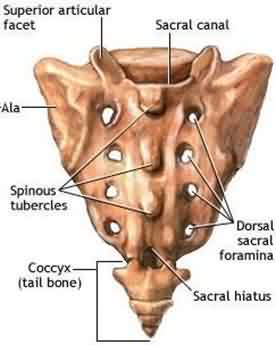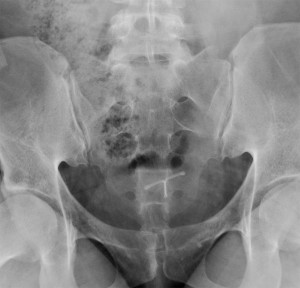
Coccygectomy recovery
Coccygectomy recovery and other post-operation answers

Figure 1B. 30-year-old female with sacral and lower back postpartum pain. The radiologist reading the outlet radiograph of the sacrum and coccyx noted a subtle cortical irregularity along the anterior cortical margin of the S3-S4 segment intervertebral level on the lateral view, suggesting possible nondisplaced fracture.
Once you’ve decided to have a coccygectomy, the next question invariably turns to the coccygectomy recovery. A coccygectomy is considered back surgery and thus can be classified as a major surgery. Recovery from back surgery is never a certain thing as it pertains to length of time for recovery and each person is unique.
Coccyx Surgery Success Rates
The success rate of coccyx removal surgery, subsequent coccyx surgery recovery and reliability of the coccyx operation is largely based on two main factors:
- Pre-operative patient selection: this includes an extensive interview from the medical profession to qualify the potential coccygectomy patient
- Experience of the surgeon: this factor is very important. As coccyx removal surgery is not very common and has a number of potentially fairly serious complications with an inexperienced surgeon, an experienced surgeon operating on patients who are good candidates for the surgery is critical for a successful coccygectomy recovery.
If both of the above criteria are met, then one can expect an 80% to 90% success rate for coccygectomy recovery.
Potential Risks and Complications of Coccyx Surgery
As mentioned previously, it is important that one uses an surgeon experienced in performing a coccygectomy to do the operation. The primary risk with coccyx removal surgery is the surgeon accidentally moving out of the subperiosteal plane around the bone during dissection and disturbing the surrounding area and muscles. The rectum lies right in front of the coccyx and, if this is violated or disturbed, there is the potential for a severe infection due the nature of the area. While it is unlikely that this will happen it is still a possibility, a diverting colostomy would be required to allow the rectum to heal properly. It is important to keep the surgical area dry post-operation to ensure minimal risk for infection.
Other potential risks that would affect coccygectomy recovery include wound healing difficulties and a potential for local infection. Unlike most other spine surgeries, there is no significant nerve root risk to are no significant nerve roots in the region that would be at risk. Perhaps the biggest risk for a successful coccygectomy recovery is continued pain in the coccyx post-operation. This means that the patient will have to endure a long healing process with no marked improvement of coccydynia symptoms.

[…] for the rest of ones life was very real. Even directly after the coccyx removal surgery and during coccyx surgery recovery, there was always an underlying and nagging ‘what if it doesn’t […]
After 8 years of pain , I have exhausted all non surgecal resources and am considering surgery. The recover time and invection rate, and risk info has been very helpful in my decisions. Thank you